Archive for October 12th, 2009
California vs. Texas – Exports
Posted by Joshua Sharf in Economics on October 12th, 2009
We all know that as California has failed, Texas has prospered. We all know that jobs and people are fleeing Paradise for Hell. We all know that it costs about 3 times as much to rent a truck from California as to make the return trip from Texas. What I haven’t seen is an analysis of the role that exports have played in this reversal.
In fact, Texas exports more that California does, and has since 2002:
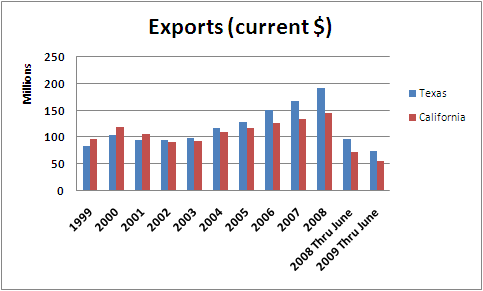
Both states have suffered from the global recession, but California on a percentage basis has suffered more, losing roughly 1/3 of its exports, while Texas has lost only about 25% of its exports year-to-date. The numbers will be at year’s end, but Texas won’t be nearly as bad off.
Some of this is accountable to a general growth in exports over the last decade, but to the extent that’s true, California hasn’t benefitted, and Texas has outperformed the rest of the country, even as its exports have outperformed the rest of its economy, while California’s have languished (watch out for the color switch):
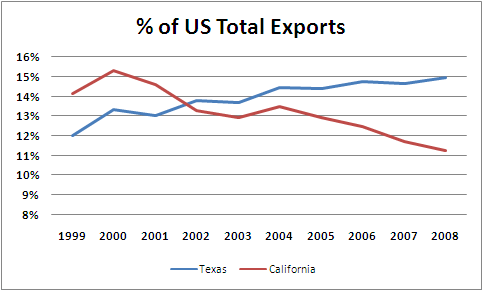
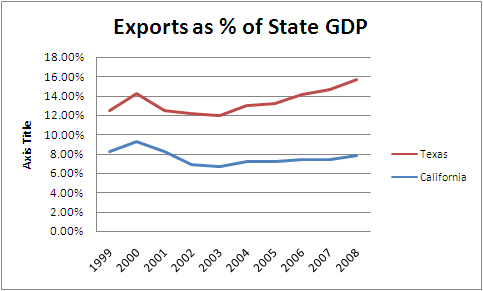
Now technically, tourism is an export, but this isn’t a result of Mexican day-visitors coming across the border for shopping and Six Flags. The biggest contributors to Texas’s export growth have been Chemical Manufactures, Petroleum and Coal Products (yes, exporting oil products), Machinery manufactures, and Computers and Electronics. Petro exports had multiplied 7x from 1999 to 2007, even before the 2008 run-up in oil prices. Over the same period, Chemical exports tripled, and Machinery exports grew by 150%.
In the meantime, California’s Silicon Valley hardware exports suffered after the dot-com bubble burst in 2000, and have never recovered. In 1999, over 50% of California’s exports were Computers & Electronics. They now constitute just under 30%, down 16% in dollar terms from 1999, and almost 1/3 from their 2000 peak. The diversification in California’s exports should be a benefit, and may yet be. But the exports are going to have to actually grow and be competitive for the state to benefit.
Here’s the comparison between a couple of sectors of the two states’ exports over the period in questions:
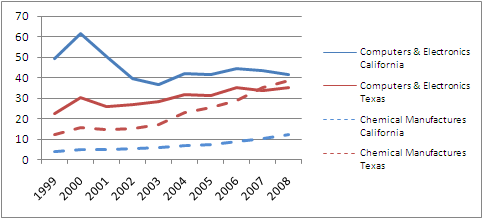
All of this might be moot if it were just a matter of underselling the competition and running sweatshops. But in fact, Texas’s GDP has been growing, and over the last decade, its per capita CDP has caught up with California:

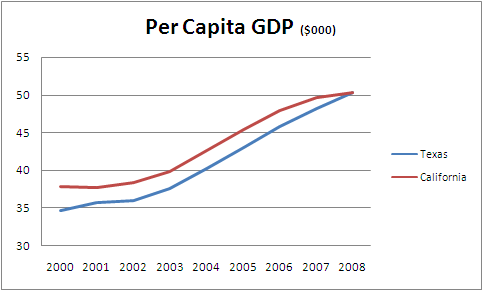
All these numbers, by the way, are from the Census Bureau, which also operates an fantastic site for cruising a state’s export numbers.
Now before we go all gaga about this, and show how this proves that under current conditions, Americans can compete with anyone overseas, these numbers don’t show how much of Texas’s exports come from cannibalizing from the rest of the country. And a State Business Tax Climate ranked #11, compared with California’s #48, would indicate that some of these exporting businesses have relocated. Still, there’s no doubt that exports are a major – and under-reported, factor in Texas’s move past California as an economic engine.
Chinese Futures Markets
Posted by Joshua Sharf in China, Economics on October 12th, 2009
The Wall Street Journal reports this morning that China is seeking to upgrade and expand its commodities futures markets in order to influence commodities prices, arguing that on-shore exchanges will help increase market efficiencies:
Government officials say the country is positioning its futures markets to be major players in setting world prices for metal, energy and farm commodities. By letting the world know how much its companies and investors think goods are worth, China hopes to be less at the mercy of markets elsewhere.
But what’s more likely is that China wants to lure traders on shore in order to use its national bargaining power to obtain more favorable prices. It’s not until the very end that the reason to be suspicious is mentioned:
International futures-market benchmarking has been slow to shift to China from long-established exchanges like the New York and Chicago venues. Despite China’s huge volumes, its futures markets allow foreigners limited access. By contrast, the London Metal Exchange says 95% of its business emanates from overseas.
General Motors Co., Ford Motor Co. and Tyson Foods Inc. are some of the companies that use futures in the U.S. to protect themselves from volatility in commodity prices. Despite expanding production in China, and being technically eligible to hedge on China’s exchanges, all three say they haven’t used its futures markets.
Instead, the big footprints in China’s futures markets belong to state-owned groups, primarily commodity trader Cofco Corp. and Beijing’s secretive stockpiling agent, the State Bureau of Material Reserve. That makes the government both player and policy maker. (emphasis added)
Right. Which means that China, which has a classic mercantilist approach to economics – seeking to use national power for the benefit of its industries – will be able to set the trading rules to its own benefit. China has been practicing what can only be described as a neocolonialist policy all over the world in pursuit of cheap commodities. It has been, as the article notes, deploying its navy to protect shipping routes, discovering the colonial truth that far from trade following the flag, the flag necessarily follows trade.
In fact, as the first paragraph in the above quote points out, these are world markets, and there’s no reason that China can’t trade openly in accounts no matter where they’re located. In fact, the three companies mentioned in the second paragraph manufacture in China, and hedge on the US markets. One likely advantage of trading with a home field advantage is that its government players won’t have to reveal their moves the way they will in more tightly regulated London and New York.
One expects that eventually, with the trading markets established, the right to continue doing business on favorable terms will come with increasing conditions, one of which may be that a company has the hedge its local commodities exposure with Chinese futures. Given the compromises that companies make to do business in China in the first place, including rarely owning 50% of their own subsidiaries and seemingly deferring profits until the late 22nd Century, hedging on local markets will just be another in a long line.
The eventual effect of such a policy, if successful, would be to drive up commodity prices for the rest of the world while keeping them low for China, hampering competition, shutting down industries in competing countries, such as the US, while allowing China’s exports and domestic markets to develop. Such a strategy only works, of course, if there’s no comparably-sized competitor, which argues for countermeasures by the US, combined with more open trade with India (which has protectionist problems of its own).
In the long run, of course, such a strategy is doomed. The imbalances that it creates will inevitably provoke a reaction from the rest of the world, such as what Japan saw in the 1980s. Moreover, it’s not sustainable forever. Exports demand markets. China is aging, and is an unlikely autarky, which is why it’s seeking to use its political (and eventually militaryp) power to secure resources. But the long run can be very long, indeed, and the damage that China can inflict on us in pursuit of this policy can be great. Which, of course, may also be all part of the plan.



